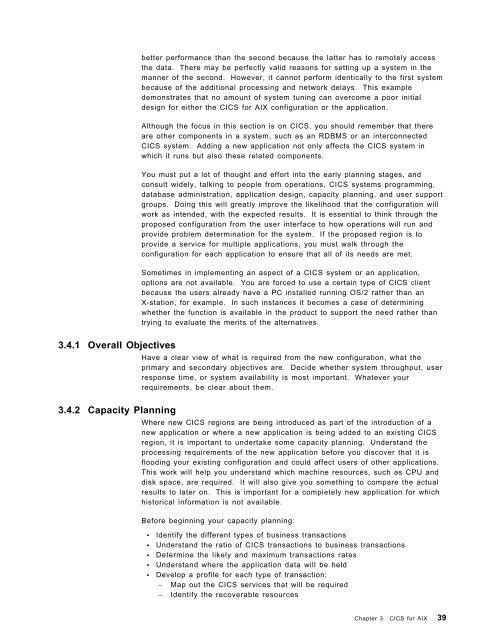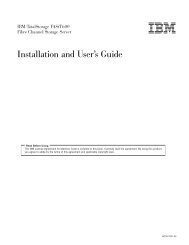Addressing OLTP Solutions with CICS: The Transaction Server ... - Ibm
Addressing OLTP Solutions with CICS: The Transaction Server ... - Ibm
Addressing OLTP Solutions with CICS: The Transaction Server ... - Ibm
Create successful ePaper yourself
Turn your PDF publications into a flip-book with our unique Google optimized e-Paper software.
3.4.1 Overall Objectives<br />
3.4.2 Capacity Planning<br />
better performance than the second because the latter has to remotely access<br />
the data. <strong>The</strong>re may be perfectly valid reasons for setting up a system in the<br />
manner of the second. However, it cannot perform identically to the first system<br />
because of the additional processing and network delays. This example<br />
demonstrates that no amount of system tuning can overcome a poor initial<br />
design for either the <strong>CICS</strong> for AIX configuration or the application.<br />
Although the focus in this section is on <strong>CICS</strong>, you should remember that there<br />
are other components in a system, such as an RDBMS or an interconnected<br />
<strong>CICS</strong> system. Adding a new application not only affects the <strong>CICS</strong> system in<br />
which it runs but also these related components.<br />
You must put a lot of thought and effort into the early planning stages, and<br />
consult widely, talking to people from operations, <strong>CICS</strong> systems programming,<br />
database administration, application design, capacity planning, and user support<br />
groups. Doing this will greatly improve the likelihood that the configuration will<br />
work as intended, <strong>with</strong> the expected results. It is essential to think through the<br />
proposed configuration from the user interface to how operations will run and<br />
provide problem determination for the system. If the proposed region is to<br />
provide a service for multiple applications, you must walk through the<br />
configuration for each application to ensure that all of its needs are met.<br />
Sometimes in implementing an aspect of a <strong>CICS</strong> system or an application,<br />
options are not available. You are forced to use a certain type of <strong>CICS</strong> client<br />
because the users already have a PC installed running OS/2 rather than an<br />
X-station, for example. In such instances it becomes a case of determining<br />
whether the function is available in the product to support the need rather than<br />
trying to evaluate the merits of the alternatives.<br />
Have a clear view of what is required from the new configuration, what the<br />
primary and secondary objectives are. Decide whether system throughput, user<br />
response time, or system availability is most important. Whatever your<br />
requirements, be clear about them.<br />
Where new <strong>CICS</strong> regions are being introduced as part of the introduction of a<br />
new application or where a new application is being added to an existing <strong>CICS</strong><br />
region, it is important to undertake some capacity planning. Understand the<br />
processing requirements of the new application before you discover that it is<br />
flooding your existing configuration and could affect users of other applications.<br />
This work will help you understand which machine resources, such as CPU and<br />
disk space, are required. It will also give you something to compare the actual<br />
results to later on. This is important for a completely new application for which<br />
historical information is not available.<br />
Before beginning your capacity planning:<br />
• Identify the different types of business transactions<br />
• Understand the ratio of <strong>CICS</strong> transactions to business transactions<br />
• Determine the likely and maximum transactions rates<br />
• Understand where the application data will be held<br />
• Develop a profile for each type of transaction:<br />
− Map out the <strong>CICS</strong> services that will be required<br />
− Identify the recoverable resources<br />
Chapter 3. <strong>CICS</strong> for AIX 39
















